warning Oldsmobile Achieva 1997 Owner's Manuals
[x] Cancel search | Manufacturer: OLDSMOBILE, Model Year: 1997, Model line: Achieva, Model: Oldsmobile Achieva 1997Pages: 372, PDF Size: 18.52 MB
Page 5 of 372
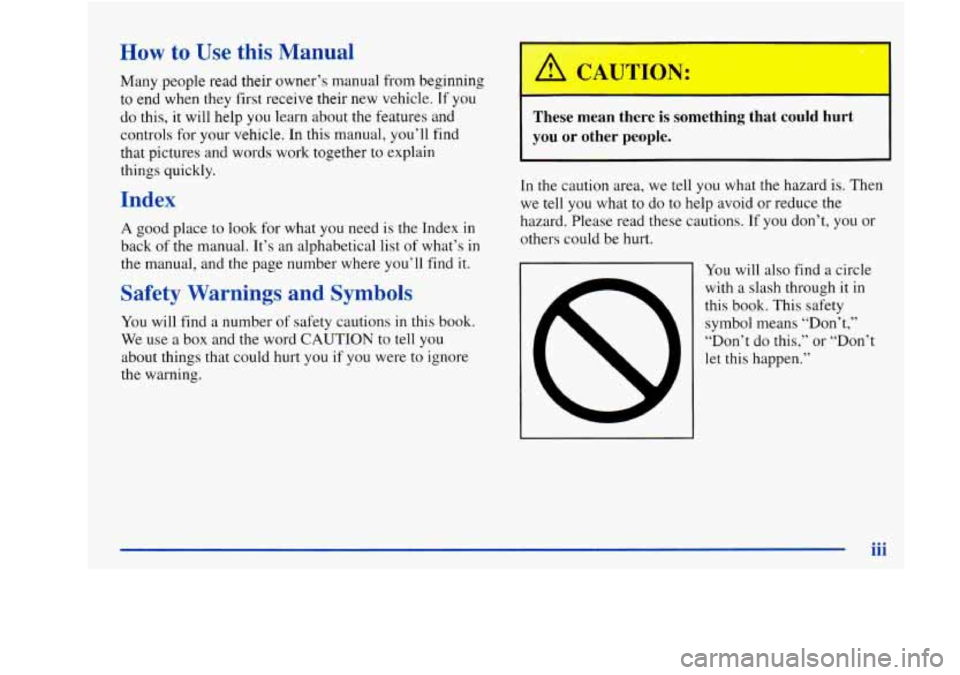
How to Use this Manual
Many people read their owner’s manual from beginning
to end when they first receive their new vehicle.
If you
do this, it will help you learn about the features and
controls for your vehicle. In this manual, you’ll find
that pictures and words work together
to explain
things quickly.
Index
A good place to look for what you need is the Index in
back of the manual. It’s an alphabetical list of what’s in
the manual, and the page number where you’ll find it.
Safety Warnings and Symbols
You will find a number of safety cautions in this book.
We use a
box and the word CAUTION to tell you
about things that could hurt you if you were to ignore
the warning.
I
These mean there is something that could hurt
you or other people.
In-the caution area, we tell you what the hazard is. Then
we tell you what to do to help avoid
or reduce the
hazard. Please read these cautions. If you don’t, you or
others could be hurt.
You will also find a circle
with
a slash through it in
this book. This safety
symbol means “Don’t,”
“Don’t do this,” or “Don’t
let this happen.”
iii
Page 6 of 372
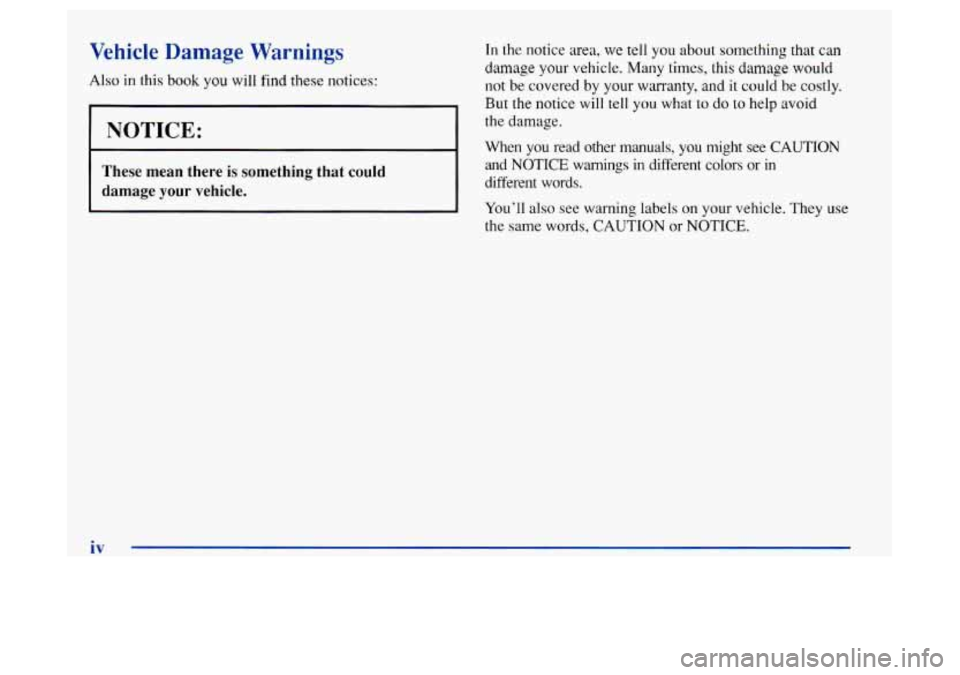
Vehicle Damage Warnings
Also in this book you will find these notices:
I NOTICE:
These mean there is something that could
damage
your vehicle.
In the notice area, we tell you about something that can
damage your vehicle. Many times, this damage would
not be covered by your warranty, and it could be costly.
But the notice will
tell you what to do to help avoid
the damage.
When
you read other manuals, you might see CAUTION
and NOTICE warnings in different colors or in
different words.
You’ll also see warning labels on your vehicle. They use
the same words, CAUTION or NOTICE.
Page 7 of 372

Vehicle Symbols
These
are some of the symbols you may find on your vehicle.
For example,
these symbols
are used
on an
original battery:
POSSIBLE A
CAUTION
INJURY
PROTECT EYES BY
SHIELDING
CAUSTIC
BURNS AVOID
SPARKS
OR
FLAMES
SPARK
OR ,\I/,
COULD FLAME
EXPLODE BATTERY
These symbols are important
for you and
your passengers
whenever your
vehicle
is
driven:
DOOR LOCK
UNLOCK
4
BELTS
n
POWER
WINDOW 'tl
These symbols have
to do wilh
your lamps:
SIGNALS e e
TURN
RUNNING
.'****o
DAYTIME LAMPS
'**
FOG LAMPS $0
These symbols
are
on some of
your controls:
WINDSHIELD
WIPER
WINDSHIELD DEFROSTER
WINDOW
DEFOGGER
VENTILATING FAN
These symbols
are used on
warning and
indicator
lights:
COOLANT -
TEMP -
CHARGING I-1
BAlTERY
SYSTEM
BRAKE
(@)
ENGINE OIL w,
PRESSURE
ANTI-LOCK
(@)
BRAKES
Here are some other symbols
you may see:
FUSE -%-
LIGHTER n
HORN )tr
SPEAKER
b
FUEL e3
Page 57 of 372
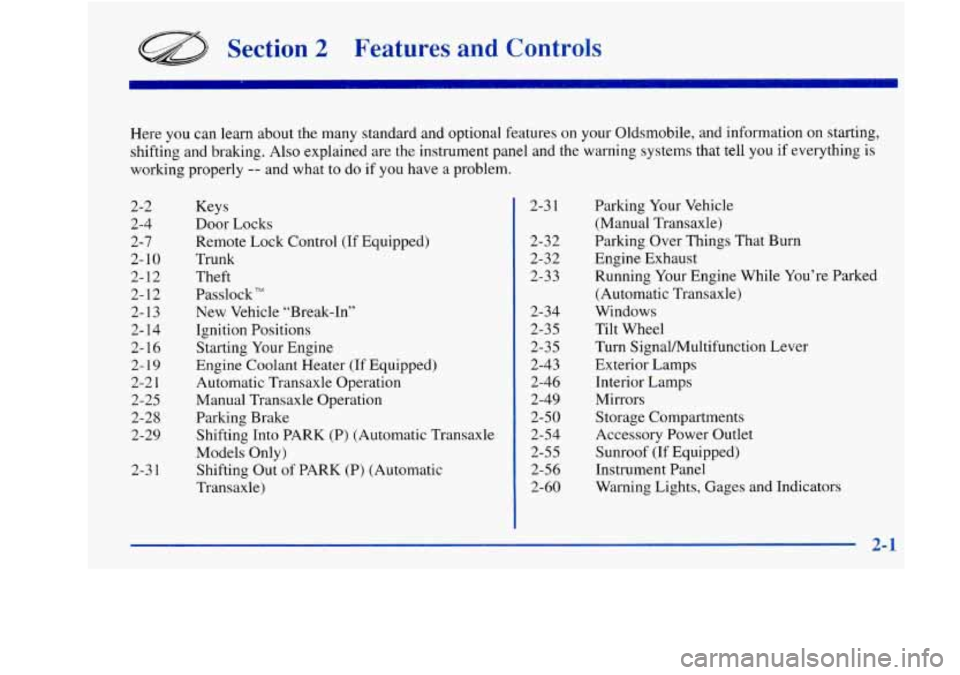
Section 2 Features and Controls
Here you can learn about the many standard and optional features on your Oldsmobile, and information on starting,
shifting and braking.
Also explained are the instrument panel and the warning systems that tell you if everything is
working properly -- and what to do if you have a problem.
2-2 2-4
2-7
2-10
2-12 2-12
2-13 2-14
2-
16
2-19
2-2
1
2-25 2-28 2-29
2-3
1
Keys
Door Locks
Remote Lock Control (If Equipped)
Trunk
Theft Passlock
TM
New Vehicle “Break-In”
Ignition Positions
Starting Your Engine
Engine Coolant Heater (If Equipped)
Automatic Transaxle Operation
Manual Transaxle Operation
Parking Brake
Shifting Into PARK (P) (Automatic Transaxle
Models Only) Shifting Out
of PARK (P) (Automatic
Transaxle) 2-3
1
2-32
2-32
2-33
1 2-34
1, 2-35
2-35
2-43
2-46
2-49
2-50
2-54
2-55
2-56
2-60 Parking
Your Vehicle
(Manual Transaxle)
Parking Over Things That Burn
Engine Exhaust
Running Your Engine While You’re Parked
(Automatic Transaxle)
Windows
Tilt Wheel
Turn SignalMultifunction Lever
Exterior Lamps
Interior Lamps
Mirrors
Storage Compartments
Accessory Power Outlet
Sunroof (If Equipped)
Instrument Panel
Warning Lights, Gages and Indicators
Page 70 of 372
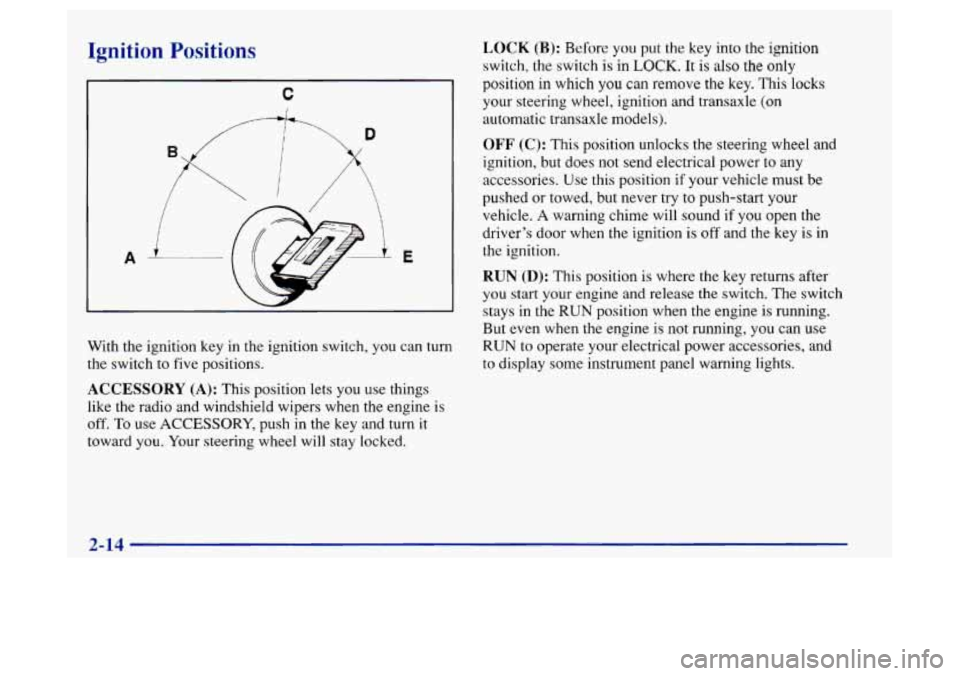
Ignition Positions
c
I
1
D
B
i
A i E
With the ignition key in the ignition switch, you can turn
the switch to five positions.
ACCESSORY (A): This position lets you use things
like the radio and windshield wipers when the engine is
off.
To use ACCESSORY, push in the key and turn it
toward
you. Your steering wheel will stay locked.
LOCK (B): Before you put the key into the ignition
switch, the switch is in
LOCK. It is also the only
position
in which you can remove the key. This locks
your steering wheel, ignition and transaxle (on
automatic transaxle models).
OFF (C): This position unlocks the steering wheel and
ignition, but does not send electrical power to any
accessories. Use this position if your vehicle must be
pushed or towed, but never try
to push-start your
vehicle. A warning chime will sound if you open the
driver’s door when
the ignition is off and the key is in
the ignition.
RUN (D): This position is where the key returns after
you start your engine and release the switch. The switch
stays in the RUN position when the engine is running.
But even when the engine is not running, you can use
RUN to operate your electrical power accessories, and
to display some instrument panel warning lights.
2-14
Page 84 of 372
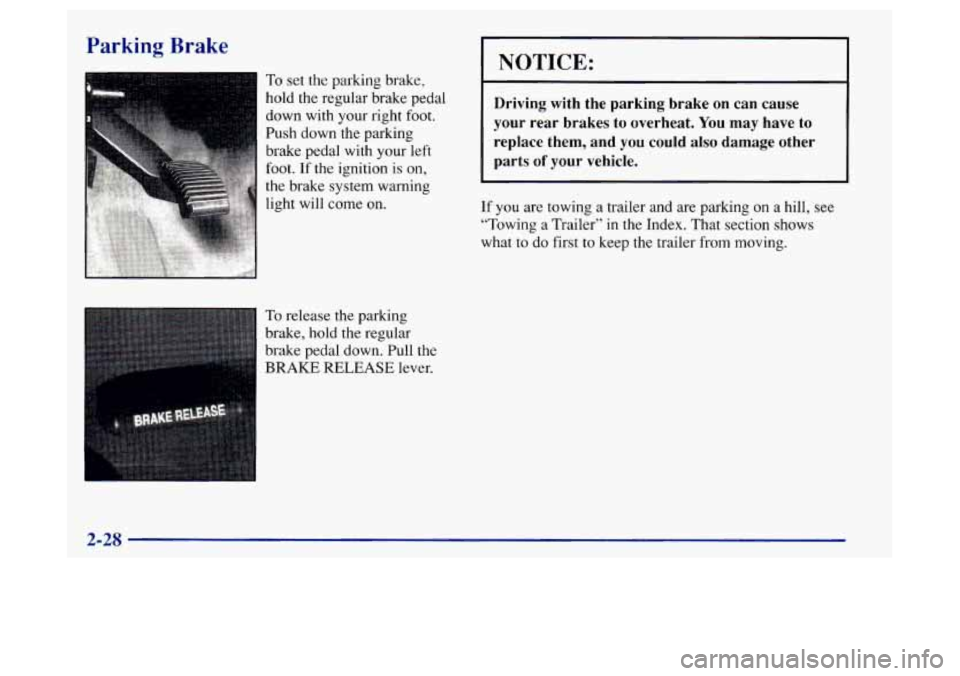
Parking Brake
To set the parking brake,
hold the regular brake pedal
down with your right foot.
Push down the parking
brake pedal with your left
foot.
If the ignition is on,
the brake system warning
ght will come on.
To release the parking
brake, hold the regular
brake pedal down. Pull the
BRAKE RELEASE lever.
NOTICE:
Driving with the parking brake on can cause
your rear brakes
to overheat. You may have to
replace them, and you could also damage other
parts
of your vehicle.
If you are towing a trailer and are parking on a hill, see
“Towing a Trailer” in t.he Index. That section shows
what to
do first to keep the trailer from moving.
2-28
Page 92 of 372
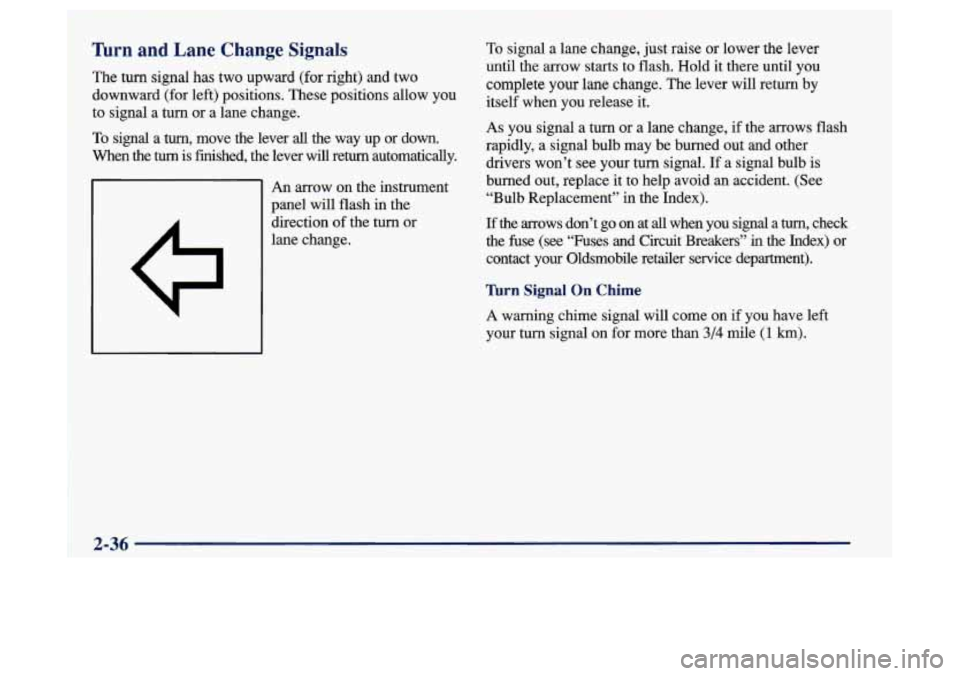
Turn and Lane Change Signals
The turn signal has two upward (for right) and two
downward (for left) positions. These positions
allow you
to signal a turn or a lane change.
To signal a turn, move the lever all the way up or down.
When the
turn is finished, the lever will return automatically.
An arrow on the instrument
panel will flash in the
direction of the
turn or
To signal a lane change, just raise or lower the lever
until the arrow starts to flash. Hold
it there until you
complete your lane change. The lever will return by
itself when you release it.
As you signal a turn or a lane change,
if the arrows flash
rapidly, a signal bulb may be burned out and other
drivers won’t see your
turn signal. If a signal bulb is
burned out, replace
it to help avoid an accident. (See
“Bulb Replacement”
in the Index).
If the arrows don’t go on at all when you signal a turn, check
the fuse
(see “Fuses and Circuit Breakers” in the Index) or
contact your Oldsmobile retailer service department).
Turn Signal On Chime
A warning chime signal will come on if you have left
your turn signal on for more than
3/4 mile ( 1 km).
2-36
Page 100 of 372
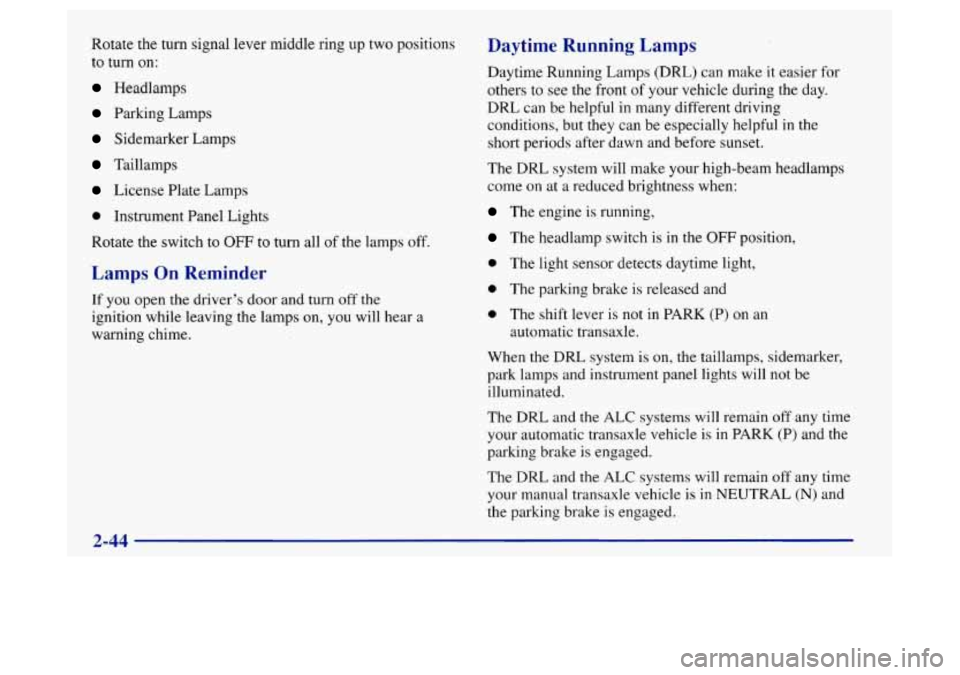
Rotate the turn signal lever middle ring up two positions
to turn on:
Headlamps
Parking Lamps
Sidemarker Lamps
Taillamps
License Plate Lamps
0 Instrument Panel Lights
Rotate the switch to
OFF to turn all of the lamps off.
Lamps On Reminder
If you open the driver’s door and turn off the
ignition while leaving the lamps on, you will hear a
warning chime.
Daytime Running Lamps
Daytime Running Lamps (DRL) can make it easier for
others to see the front
of your vehicle during the day.
DRL can be helpful in many different driving
conditions, but they can be especially helpful
in the
short periods after dawn and before sunset.
The DRL system will make your high-beam headlamps
come on at a reduced brightness when:
The engine is running,
The headlamp switch is in the OFF position,
0 The light sensor detects daytime light,
0 The parking brake is released and
0 The shift lever is not in PARK (P) on an
automatic transaxle.
When the DRL system is on, the taillamps, sidemarker,
park lamps and instrument panel lights will not be
illuminated.
The DRL and the ALC systems will remain off any time
your automatic transaxle vehicle is
in PARK (P) and the
parking brake
is engaged.
The DRL and the ALC systems will remain off any time
your manual transaxle vehicle is in NEUTRAL
(N) and
the parking brake is engaged.
2-44
Page 113 of 372
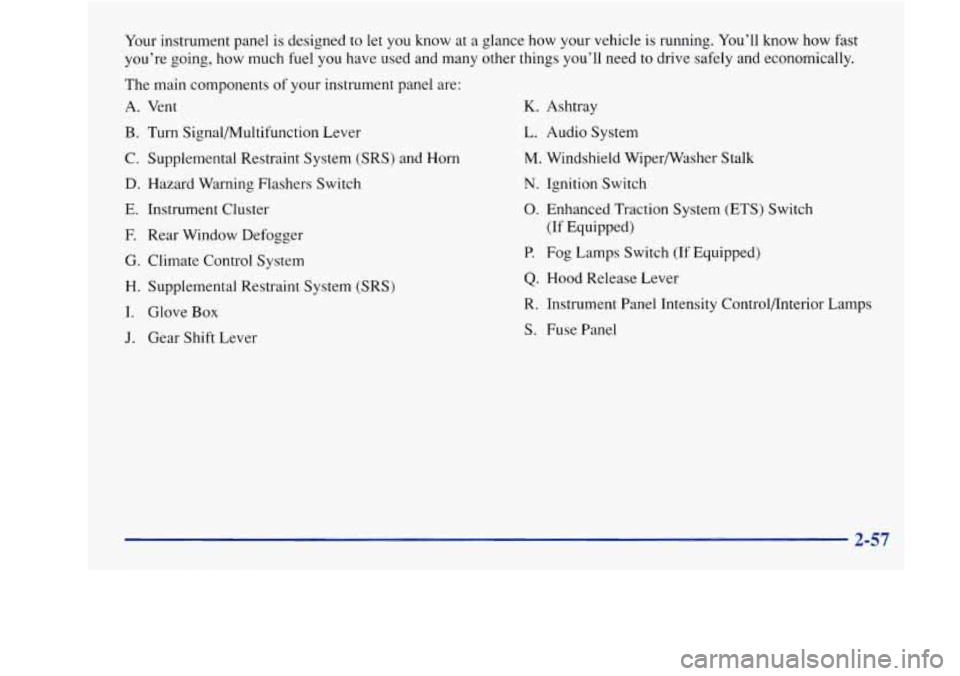
Your instrument panel is designed to let you know at a glance how your vehicle is running. You’ll know how fast
you’re going, how much fuel you have used and many other things you’ll need to drive safely and economically.
The main components
of your instrument panel are:
A. Vent
B. Turn Signal/Multifunction Lever
C. Supplemental Restraint System (SRS) and Horn
D. Hazard Warning Flashers Switch
E. Instrument Cluster
E Rear Window Defogger
G. Climate Control System
H. Supplemental Restraint System (SRS)
I. Glove Box
J. Gear Shift Lever
K. Ashtray
L. Audio System
M. Windshield Wipermasher Stalk
N. Ignition Switch
0. Enhanced Traction System (ETS) Switch
(If Equipped)
P. Fog Lamps Switch (If Equipped)
Q. Hood Release Lever
R. Instrument Panel Intensity Control/Interior Lamps
S. Fuse Panel
2-57
Page 114 of 372
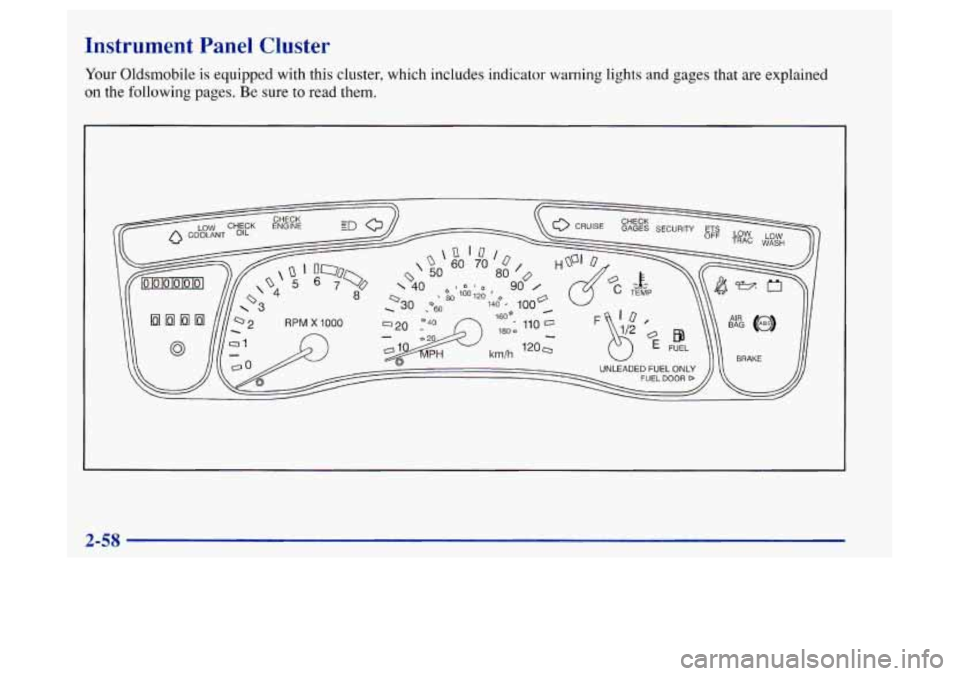
Instrument Panel Cluster
Your Oldsmobile is equipped with this cluster, which includes indicator warning lights and gages that are explained
on the following pages. Be sure to read them.
2-58